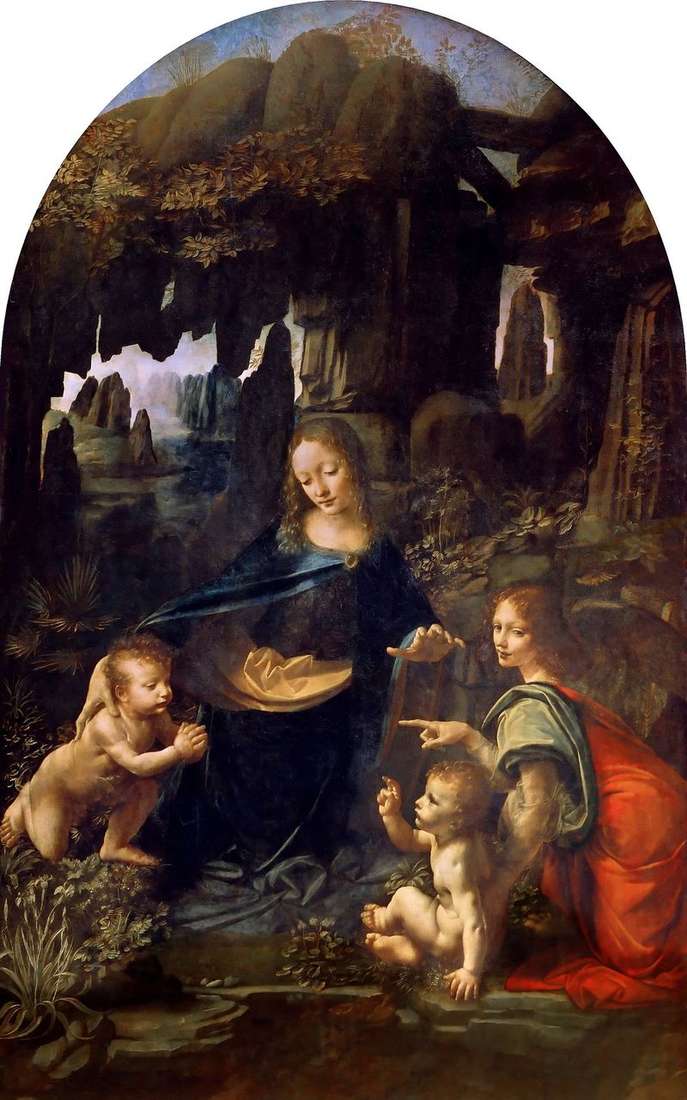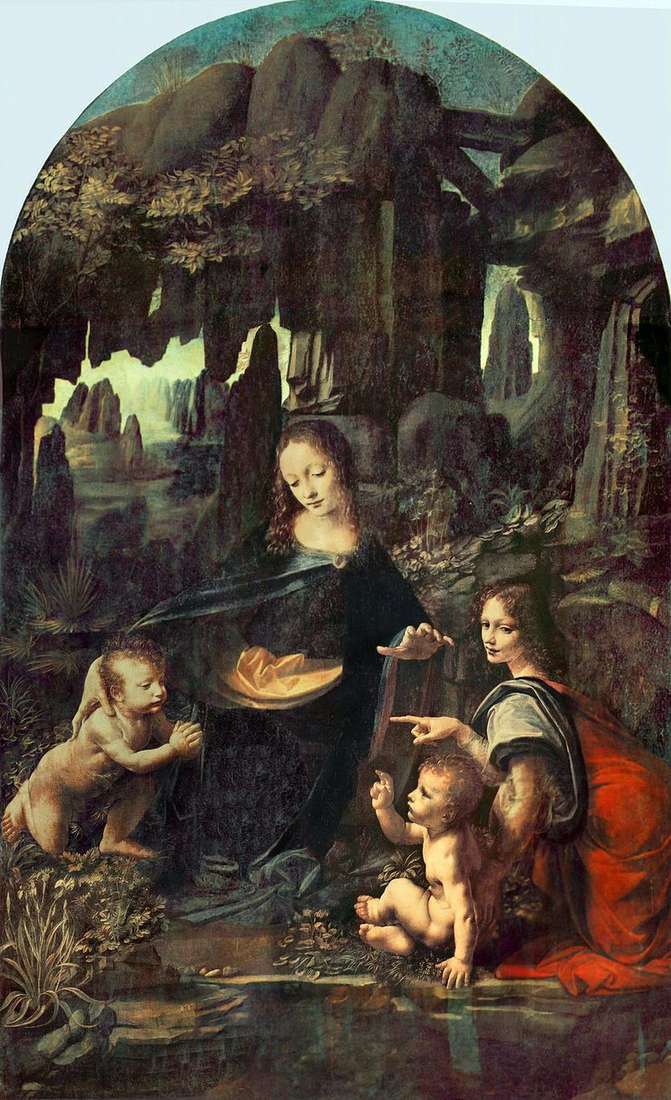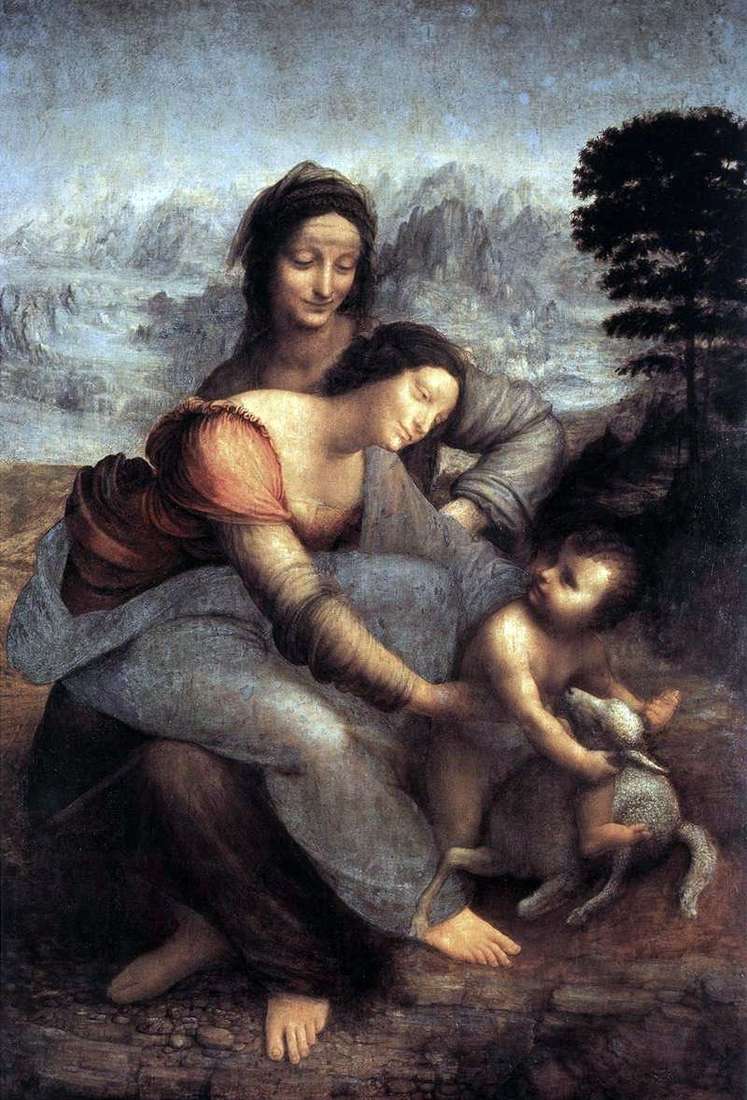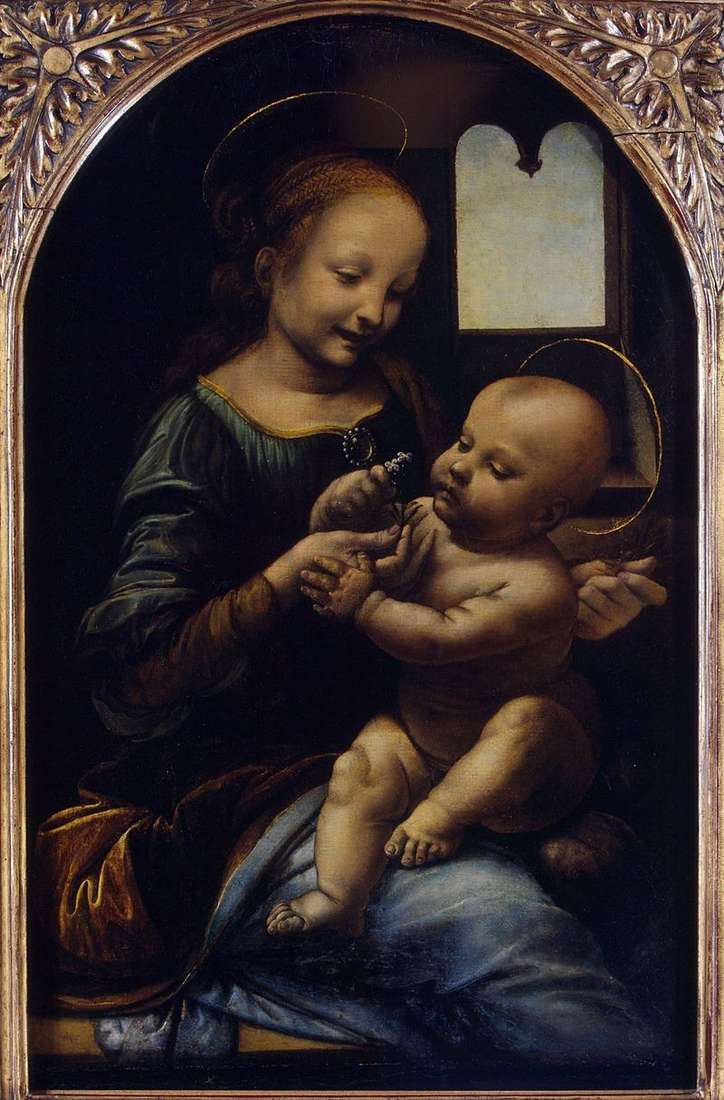
Maria, in dark blue clothes, sits or kneels, almost in the center of the group. She gazes intently and gently at the supplicant John, his right arm hugging his shoulders, while her left hand is raised defensively over Jesus. Angel gazes out of the picture with a quiet smile, establishing contact with the audience. The right hand, because the angel is the guardian of John, the angel points to him, and the left one – he supports the baby Jesus, who looks at John, lifting one hand in blessing. Thus, the group is connected by looks and gestures, with the viewer. It seems that the rocky, stone foot in the foreground is falling sharply. This immediately makes it clear that the place is distant and isolated, and this is emphasized by the wild rocks around.
In several places between the rocks there are water and mountains in the fog. The radiance of the background, the flickering of water and plants soften the inhospitable atmosphere of the rocks. This effect is continued in light. Some of these elements can be read as religious symbols: water and pearls and crystal that are used to fortify Mary’s clothing can be taken as symbols of her purity. The formation of the rock can also be read as Mary’s symbols: the pure image of the Mother of God – like a rock, can not turn into a crevice created by a human hand, nor in uninvolved stone blocks, destroyed by natural forces. Besides, the rock, the grotto among the rocks, means a refuge for the baby John and Christos. In 1483, having arrived in Milan, Leonardo received an order from the Brotherhood in the Church of St. Francisco. The Brotherhood commissioned Leonardo, along with two local artists, the Predis brothers,
The contract contained detailed instructions for artists regarding the painting and gilding of the great altar altar, which the carpenter had already finished in 1482. Leonardo wrote a central group that survived in two versions. The eldest of the two is in the Louvre, in Paris, while the second version is in the National Gallery, in London. The sides, with two music-making angels, written by Leonardo’s colleague, Ambrogio de Predis, are in the same gallery in London. The picture is the central group of the great altar altar. On the right and left are large figures of angels. The decoration complements the scenes depicting the life story of Mary and the sculptures of the prophets and God the Father is higher. In the niche in the center of the table there is a wooden sculpture of Madonna and child.
The picture of Leonardo was then placed in the guides in front of this niche, hiding the sculpture of Madonna and Child – for 364 days of the year. Only on December 8, on a holiday, Leonardo’s painting was mechanically moved away. Leonardo portrayed the Virgin Mary with the baby, St. John the child, and the angel in the rocky grotto – hence, the name under which we know the picture today is fair. 199h122.1483-86 On April 25, 1483, members of the local brotherhood of the Immaculate Conception asked the artist to paint a picture for the altar of the chapel. Obviously, this was Leonardo’s first picturesque order in Milan. The Duke of Sforza, who was employed by the Florentine, first used his talents mainly for the arrangement of palace festivities.
However, Leonardo did this not without pleasure – there was room for imagination and the opportunity to carry out their engineering projects. Painting for Leonardo was also a field for experiment. Fulfilling the order of the Brotherhood, he used the technique of the Sfumato, which he invented, which from now on became a characteristic feature of his painting. The objects on his canvases do not have clear boundaries: everything, as in nature, is blurred, penetrates one into another, and therefore breathes, lives, awakens the imagination. The Italian advised students to practice in such a scattering, examining the stains from the dampness on the walls, ash, clouds or mud. The smoke envelops the figures of Mary, two babies – Jesus and John – and the Angel. The Angel’s face is not male or female.
The artist painted the face of an asexual creature, which, of course, angels should be. The landscape that opens behind Maria seems fantastic. But Leonardo himself argued that painting is a science. As can be seen from the drawings of that time, he was engaged in the study of geological phenomena and plants. His knowledge, he transferred to the picture. You can determine the type of plants depicted here. Leonardo even passed their property to turn after the sun. There is another picture “Madonna in the rocks,” written later.
It is believed that its appearance is connected with this. Leonardo very badly led his money affairs. He often overdue the order, for which he had to pay large forfeits of the money that he was given during work. But he spent them always faster than finishing the picture and could not pay fines. As a result, he was followed by a long train of complaints and lawsuits. But he was lucky: invariably appeared benefactor, usually, his next patron, who paid his debts. So it happened this time. The patron was the French King Louis XII. In gratitude, Leonardo gave him the first version of “Madonna in the rocks.” And for the chapel, he or his disciples made a copy.
 Madonna in the rocks (Madonna in the grotto) by Leonardo da Vinci
Madonna in the rocks (Madonna in the grotto) by Leonardo da Vinci The Virgin Mary with a child and St. Anna by Leonardo da Vinci
The Virgin Mary with a child and St. Anna by Leonardo da Vinci Saint Anna and Mary with the Infant Christ by Leonardo Da Vinci
Saint Anna and Mary with the Infant Christ by Leonardo Da Vinci Madonna with spinning wheel by Leonardo Da Vinci
Madonna with spinning wheel by Leonardo Da Vinci Madonna with the Child and Saint Anna by Leonardo da Vinci
Madonna with the Child and Saint Anna by Leonardo da Vinci Madonna and Child, Anna and John by Leonardo da Vinci
Madonna and Child, Anna and John by Leonardo da Vinci St. John the Baptist by Leonardo da Vinci
St. John the Baptist by Leonardo da Vinci Madonna with a flower (Madonna Benoit) by Leonardo da Vinci
Madonna with a flower (Madonna Benoit) by Leonardo da Vinci